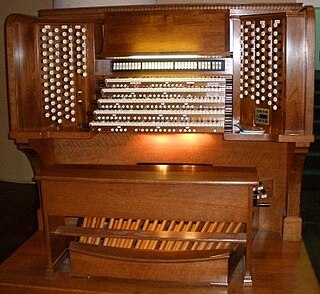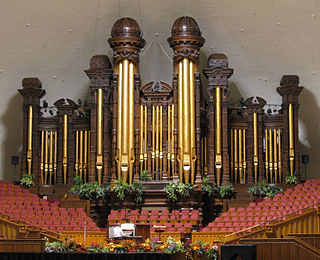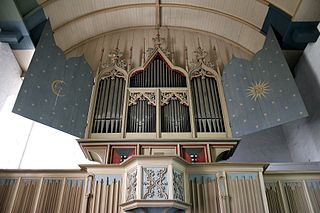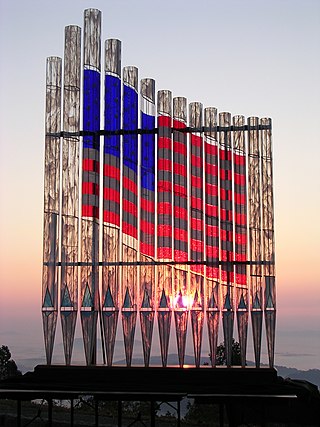Related Research Articles

The pipe organ is a musical instrument that produces sound by driving pressurised air through the organ pipes selected from a keyboard. Because each pipe produces a single pitch, the pipes are provided in sets called ranks, each of which has a common timbre, volume, and construction throughout the keyboard compass. Most organs have many ranks of pipes of differing pitch, timbre, and volume that the player can employ singly or in combination through the use of controls called stops.

In music, the organ is a keyboard instrument of one or more pipe divisions or other means for producing tones. The organs have usually two or three, up to five, manuals for playing with the hands and a pedalboard for playing with the feet. With the use of registers, several groups of pipes can be connected to one manual.

The Chautauqua Institution is a 501(c)(3) nonprofit education center and summer resort for adults and youth located on 2,070 acres (840 ha) in Chautauqua, New York, 17 miles (27 km) northwest of Jamestown in the western southern tier of New York state. Established in 1874, the institution was the home of, and provided the impetus for, the Chautauqua movement that became popular in the United States in the late 19th and early 20th centuries. The Chautauqua Institution Historic District is listed on the National Register of Historic Places and was further designated a National Historic Landmark.

An organ stop is a component of a pipe organ that admits pressurized air to a set of organ pipes. Its name comes from the fact that stops can be used selectively by the organist; each can be "on", or "off".

Rodgers Instruments Corporation is an American manufacturer of classical and church organs. Rodgers was incorporated May 1, 1958 in Beaverton, Oregon by founders, Rodgers W. Jenkins and Fred Tinker, employees of Tektronix, Inc., of Portland, Oregon, and members of a Tektronix team developing transistor-based oscillator circuits. Rodgers was the second manufacturer of solid state oscillator-based organs, completing their first instrument in 1958. Other Rodgers innovations in the electronic organ industry include solid-state organ amplifiers (1962), single-contact diode keying (1961), reed switch pedal keying for pedalboards (1961), programmable computer memory pistons (1966), and the first MIDI-supported church organs (1986).

An electric organ, also known as electronic organ, is an electronic keyboard instrument which was derived from the harmonium, pipe organ and theatre organ. Originally designed to imitate their sound, or orchestral sounds, it has since developed into several types of instruments:

A theatre organ is a type of pipe organ developed to accompany silent films from the 1900s to the 1920s.

Casavant Frères is a Canadian organ building company in Saint-Hyacinthe, Quebec, which has been building pipe organs since 1879. As of 2014, the company has produced more than 3,900 organs.
Mathias Peter Møller, commonly known as M.P. Möller or Moeller, was a prolific pipe-organ builder and businessman. A native of the Danish island of Bornholm, he emigrated to the United States in 1872 and founded the M.P. Moller Pipe Organ Company in Greencastle, Pennsylvania, in 1875. The city of Hagerstown, Maryland, took notice of Möller's early successes and induced him to move his business there in 1881 to help make it a viable business center in Western Maryland. The company remained in business in Hagerstown until 1992, with hundreds of employees at its peak and a lifetime production of over 12,000 instruments.

The symphonic organ is a style of pipe organ that flourished during the first three decades of the 20th century in town halls and other secular public venues, particularly in the United States and the United Kingdom. It has roots in 19th-century Europe, and is a variation of the classical pipe organ. It features expanded capabilities, with many pipes imitative of orchestral instruments, and with multiple expressive divisions and organ console controls for seamlessly adjusting volume and tone, generally with electric organ actions and winding. These expansions let the organist approximate a conductor's power to shape the tonal textures of Romantic music and orchestral transcriptions. These organs are generally concert instruments as opposed to church organs. The symphonic organ has seen a revival in the US, Europe and Japan, particularly since the 1980s.

The Wanamaker Grand Court Organ, located in Philadelphia, Pennsylvania, is the largest fully functioning pipe organ in the world, based on the number of playing pipes, the number of ranks and its weight. The Wanamaker Organ is located within a spacious 7-story Grand Court at Macy's Center City and is played twice a day Monday through Saturday. The organ is featured at several special concerts held throughout the year, including events featuring the Friends of the Wanamaker Organ Festival Chorus and Brass Ensemble.

Heinz Memorial Chapel is a Pittsburgh History and Landmarks Foundation Historic Landmark and a contributing property to the Schenley Farms National Historic District on the campus of the University of Pittsburgh in Pittsburgh, Pennsylvania, United States.

Austin Organs, Inc., is a manufacturer of pipe organs based in Hartford, Connecticut. The company is one of the oldest continuously-operating organ manufacturers in the United States. The first instruments were built in 1893 with the Austin Patent Airchest, and many remain in fine playing condition to this day.

The Spreckels Organ Pavilion is an outdoor venue that houses the open-air Spreckels Organ in Balboa Park in San Diego, California. With more than 5,000 pipes, the Spreckels Organ is the world's largest pipe organ in a fully outdoor venue. Constructed for the 1915 Panama-California Exposition, it is located at the corner of President's Way and Pan American Road East in the park.

The Salt Lake Tabernacle organ is a pipe organ located in the Salt Lake Tabernacle in Salt Lake City, Utah. Along with the nearby Conference Center organ, it is typically used to accompany the Tabernacle Choir at Temple Square and is also featured in daily noon recitals. It is one of the largest organs in the world. Jack Bethards, president and tonal director of Schoenstein & Co., describes it as an "American classic organ" and "probably one of the most perfect organs ever built."
Registration is the technique of choosing and combining the stops of a pipe organ in order to produce a particular sound. Registration can also refer to a particular combination of stops, which may be recalled through combination action. The registration chosen for a particular piece will be determined by a number of factors, including the composer's indications, the time and place in which the piece was composed, the organ the piece is played upon, and the acoustic environment within which the organ resides.

The Rysum organ in Rysum Church in Rysum, north Germany, is the oldest instrument of its kind in northern Europe that still largely has its original pipes. It is also one of the oldest playable church organs in the world alongside those in Sion, St. Valentin in Kiedrich, and Ostönnen. The exact date of its construction is not entirely known, but dates of 1457 and 1440 have been proposed. It was rebuilt in 1513. After undergoing several other modifications through the years it was restored to its 1513 condition by Jürgen Ahrend and Gerhard Brunzema in 1959. The organ has seven stops on one manual.

Xaver Wilhelmy is an inventor, designer and certified pipe organ builder who was the first in the world to create organ pipes from glass. Wilhelmy created the Wilhelmy American Flag Glass Pipe Organ, the first pipe organ in the world with pipes made entirely from glass.
Charles Brenton Fisk was an American pipe organ builder. He was one of the first to use mechanical tracker actions instead of electro-pneumatic actions in modern organ construction. Originally involved in the Manhattan Project, Fisk made a career change from atomic physics to organ building. He later co-founded C.B. Fisk, Inc., an organ building firm.
References
- ↑ Vidaver, Lois (August 2007). "One Hundred Years of Massey Magic". The American Organist. Archived from the original on 2016-10-08. Retrieved September 28, 2016.
- ↑ "Chautauqua Amphitheater Structural History" (PDF). Chautauqua Institution. Archived from the original on August 26, 2016.
{{cite web}}: CS1 maint: unfit URL (link) - ↑ Steves, Jordan (September 15, 2016). "September Amphitheater Update". Chautauqua Institution.